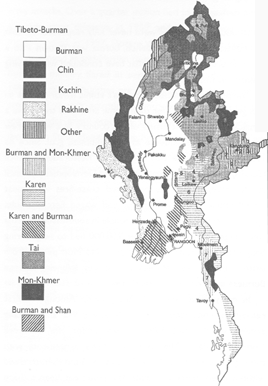The failure to address the concerns of Burma’s ethnic groups lies at the heart of Burma’s problems. Burma’s ethnic minorities have been struggling for ethnic and political rights for decades as successive dictators in Burma have pursued a policy of ‘Burmanisation’, which ranges from repressing the teaching of ethnic history, language and culture, to military attacks against civilians.
Lack of a reliable census makes it impossible to more than roughly estimate the composition of Burma’s ethnic mosaic or its total population. Some experts suggest existing population data is skewed to exaggerate the number of Burman, who are the largest single ethnic group. According to available statistics, they comprise about two-thirds of Burma’s approximately 50 million people, and dominate the army and government. Most of Burma’s ethnic minorities inhabit areas along the country’s mountainous frontiers. Karen and Shan groups comprise about 10% each, while Akha, Chin, Chinese, Danu, Indian, Kachin, Karenni, Kayan, Kokang, Lahu, Mon, Naga, Palaung, Pao, Rakhine, Rohingya, Tavoyan, and Wa peoples each constitute 5% or less of the population.
Burma has experienced a long history of migration and conflict among various ethnic groups along fluid frontiers, which were finally fixed only during British imperial rule from the 1820s to 1948. Under British control, diverse peoples far from Rangoon were brought under at least nominal central administration. Yet many areas remained effectively self-ruled, with only a thin veneer of imperial oversight. During World War II, while many Burman joined Japanese forces, many minority ethnic groups remained loyal to Britain. This reflected a genuine desire for independence on the part of both groups; Burmans struggling to be free of the British colonial yoke, and ethnic minorities wishing to escape Burman domination.
The Union of Burma became independent in I948 only after extensive negotiations led by General Aung San, who convinced most ethnic minority groups to join the new union. The Panglong Agreement of 1947 outlined minority rights and specifically gave the Shan and Karenni peoples the option to secede from the union a decade after independence. Yet these constitutional guarantees were never fully respected. Almost immediately upon independence, Burma was thrown into a series of brutal ethnic wars that have continued with varying intensity to this day.

The principal demands of Burma’s ethnic minorities are to gain genuine autonomy for their home areas and to achieve a significant voice in the affairs of the country as a whole. Since its 1988 coup, the State Law and Order Restoration Council (SLORC) (renamed the State Peace and Development Council in November I 997), has negotiated cease-fires with most armed ethnic opposition groups and waged fierce assaults against others. Muslim Rohingya people in southwestern Burma were targeted in 1991, and over 250,000 fled to neighboring Bangladesh.
At least 140,000 more Karen, Karenni, and Mon people from eastern Burma are refugees in Thailand following intense Burmese army offensives since 1984. Many Shan people have been forced to flee army assaults as well. In several areas, there are massive numbers of Internally Displaced Persons (IDPs), mostly villagers who have fled their homes to escape conscription as military porters or other abuses. The suffering of Burma’s estimated 600,000 IDPs is often far worse than refugees in neighboring countries, who receive at least some outside aid.
Among the earlier cease-fires concluded were with ethnic Wa and Kokang armies, which until 1987 served under the Burmese Communist Party. The Burmese army’s agreements with these groups permit opium cultivation and the right to trade without interference. The result has been a sharp increase in heroin production and smuggling from Burma and a concurrent worldwide rise in heroin use and addiction. These groups are now also engaged in large-scale illicit manufacture of methamphetamines. Some other ethnic opposition organisations, particularly the Kachin Independence Organization and the Karen National Union, have taken strong stands against drug production and trafficking. The junta has exploited divisions within and among ethnic groups to bolster its rule. In 2000, the relocation of thousands of Wa farmers into traditional Shan areas raised tensions and sparked fighting between those groups.
The regime’s new constitution, which came into force after the fake elections in November 2010, not only guarantees continued dictatorship, but also denies any ethnic rights. It does not grant ethnic people any real level of autonomy, or grant any protection or promotion of ethnic cultures. There cannot be democracy or lasting peace and stability in Burma if the rights of ethnic people continue to be ignored.
Burma’s New Constitution – Denying Ethnic Rights
This briefing looks at the wide-ranging negative impacts Burma’s new Constitution will have on ethnic groups in Burma.
